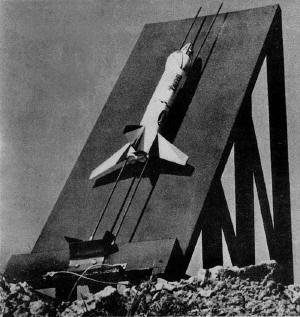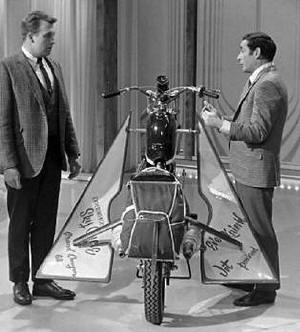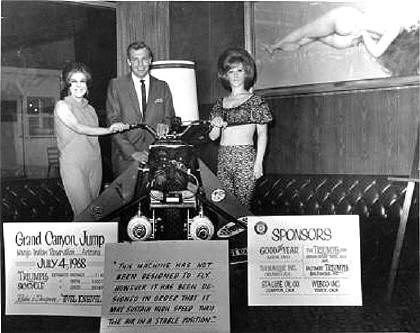|
The above is what was on display.
I instantly realized that the machine was 100% bogus!
#1 - The claimed jets were instantly recognizable
as Turbonique of Florida monopropellant rocket motors. You
can see these bottle shaped thrust units mounted on each side of the
rear wheel. Typically a high pressure nitrogen tank would be used
to push the special Turbonique Thermolene monopropellant from its tank
into the combustion chamber (the bottle shaped motors).
Instead, plumbing lines were routed directly from the motorcycle
gasoline tank to the rocket motors. There were NO nitrogen or
monopropellant tanks!
#2 - The machine's "supposed" wings were mere thin
plates instead of true airfoils. They had a useless aspect ratio
and worse were mounted at an angle-of-attack of about 45 degrees - way
past any feasible stall angle-of-attack! All they would do is add
a lot of aerodynamic drag and provide a useless amount of lift.
#3 - There was no way this contraption could fly
through the air in a stable manner. Nothing to provide either
pitch OR yaw stability.
I made those observations to Tom Cameron and was
ready to leave, when Tom suggested I leave Evel a letter
describing what I had figured out. I thought that would be
being presumptuous, but Tom kept bugging me. A few minutes later I
yielded. Tom & I went to the receptionist at the dealership, got a
few sheets of paper and borrowed her pen. 20 minutes or so later I
gave her 3 pages of scribbling and my Centuri business card and the
receptionist put it in an envelope and said she would give it to Mr.
Knievel.
Surprise, surprise. The very next afternoon,
I get a call at the office from Evel. He actually started the
conversation by chewing me out which was kind of astonishing to me - the
young, kind of shy, nerdy engineer. I don't think he wanted to
admit his canyon jumping machine was bogus, but he knew that I knew.
After he was done berating me, I told him I could help design him
something that would fly properly. I next said I said I
could show him how it could be done safely and volunteered to build a
small version and launch it for him. This would be a small two
wheeled rocket that would demonstrate stable flight and full parachute
recovery. He was intrigued and asked how long would it take to
build one? Told him it would just take a couple of days. It
was then his idea to have me launch it as part of his motorcycle jump
show the following Saturday at Beeline Drag way.
|
 |
This is a photo of the
actual launch ramp and dual solid propellant rocket motor powered
model we built and flew for Evel at the Beeline drag strip on
Saturday May 25, 1968. The two solid propellant rocket
motors were ignited electrically. The two rods shown guide
the model while it accelerates to a speed where the air flowing
over the three rear fins is fast enough to provide the needed
aerodynamic stability through powered flight and coasting (works
just like an arrow). Performance calculations were also
required to establish the optimum time to deploy the parachutes.
Too early and the parachute could be ripped off from excessive
speed. Too late and you could be too close to the ground
when the nose cone was blown off and the parachute ejected to
enable full inflation and deceleration for a safe landing.
It was already dark when we were
asked to launch the rocket. It made a bright streak across the
night time sky as it streaked upward (imagine a meteor in
reverse). The parachute deployed and inflated and the model
gently floated to earth. BUT Evel missed the show and only
heard about the flight second hand. Unfortunately,
Evel was in the hospital! While rehearsing that very
afternoon, Knievel crashed and ended up breaking his right leg and
foot. He was NOT at the drag way that evening, he was in a
hospital bed! |
That night may 25, 1968, the crowd of 10,000
spectators that paid to see Evel jump were not informed of Evel's mishap
till around 9 PM, some time after we launched the demo canyon jumping
rocket down the center of the drag strip. In Evel's place, his
colleague in self administered mayhem, Jack Stroh had the jumping
honors. Jack had never jumped this far. They reduced
the 15 Mustangs to 10. He totally cleared the distance and landed
beyond the ramp. The motorcycle bottomed out and made a
torrent of sparks and smoke upon impact with the asphalt. It
looked like Jack was fine, but slowly, ever so slowly, the bike leaned
more and more to the left as it rolled along and ended up drifting off
the asphalt road, onto the grass. It fell over in a cloud of dust
a hundred yards beyond the landing point. It turned out that Jack
was dazed and almost unconscious from the landing impact because
his head hit hard into the motorcycle's instrument panel. His chin
was sliced pretty bad, so the ambulance crew drove him away to Mesa
Lutheran Hospital where, preceding him, the maestro already lay.
I can't remember if it was the next day or a
couple of days later that I got a call from Evel. He got the word
from his associates that our canyon jumping model flew perfectly and and
wanted to talk further. He invited me to visit him at the
hospital. That afternoon I drove there and was greeted by his
lovely wife Linda Knievel, sitting in a chair outside his room.
She beckoned me to go in. Wouldn't you know it - a gorgeous blonde
go-go show girl was sitting at Evel's bed side. More CLASSIC
Knievel. He promptly shooed her out so we could talk. Within
a half hour of chatting, I became the official Evel Knievel canyon
jumping rocket motorcycle engineer! Little did I know what an
interesting adventure this first face-to-face meeting would lead to for
the young nerdy rocket engineer - me!
There is a famous John Lennon quote "Life is
what happens to you while you are making other plans." It
sure applies to me. I never would have been
associated with Evel Knievel without the intervention and prodding by
Tom Cameron to leave Evel that technical letter at the Ford
dealership...
|


